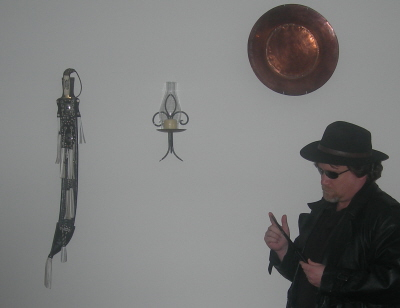|
About This Author
Come closer.
|
Complex Numbers
Complex Numbers
A complex number is expressed in the standard form a + bi, where a and b are real numbers and i is defined by i^2 = -1 (that is, i is the square root of -1). For example, 3 + 2i is a complex number.
The bi term is often referred to as an imaginary number (though this may be misleading, as it is no more "imaginary" than the symbolic abstractions we know as the "real" numbers). Thus, every complex number has a real part, a, and an imaginary part, bi.
Complex numbers are often represented on a graph known as the "complex plane," where the horizontal axis represents the infinity of real numbers, and the vertical axis represents the infinity of imaginary numbers. Thus, each complex number has a unique representation on the complex plane: some closer to real; others, more imaginary. If a = b, the number is equal parts real and imaginary.
Very simple transformations applied to numbers in the complex plane can lead to fractal structures of enormous intricacy and astonishing beauty.
March 18, 2023 at 12:57pm March 18, 2023 at 12:57pm
| |
"Sure, astronomy's interesting, but what use is it?"
And they said science and the arts were incompatible.
It’s a well known fact that an 18-year-old Mary Shelley (then still Mary Wollstonecraft, after her mother) wrote Frankenstein at Lord Byron’s house (actually a rented mansion on Lake Geneva) after the poet, during a streak of bad weather, challenged his house guests to write their own ghost stories.
So well-known, in fact, that they have to lead with it.
The article goes on to describe, in Shelley's early-19th-century words, how she struggled to come up with said "ghost story."
The problem, in hindsight, was that she needed to invent an entire genre of literature to get her story across.
But then one night, when she had gone to bed late—after “the witching hour had gone by”—it came to her. “When I placed my head on my pillow, I did not sleep, nor could I be said to think,” she wrote.
My imagination, unbidden, possessed and guided me, gifting the successive images that arose in my mind with a vividness far beyond the usual bounds of reverie. I saw—with shut eyes, but acute mental vision,—I saw the pale student of unhallowed arts kneeling beside the thing he had put together. I saw the hideous phantasm of a man stretched out, and then, on the working of some powerful engine, show signs of life, and stir with an uneasy, half vital motion.
The state between waking and sleep is called "hypnagogic." That's from some Greek words for "leading to sleep" (or so I'm told). When I read those words for the first time, reading the novel when I was much younger, that's the first thing I thought of—that she'd experienced a hypnagogic hallucination, something kin to a dream.
Explaining it might ward off any supernatural explanation, but it doesn't take away from her creativity and originality one bit. In fact, it enhances it: that vision wasn't sent by a muse or a god, but sprung like Athena from her own mind.
Well. Back to the astronomy part:
Reports have differed as to how long it actually took Shelley to come up with her story—one night? three?—and some scholars have questioned Shelley’s timeline. But ten years ago, astronomers at Texas State University used astronomical tables and topographic measurements to pinpoint the exact hour that fateful vision came to her. Like any good legend, it all hung on the position of the moon.
And, honestly, that's a thin hook indeed.
“There is no explicit mention of a date for the ghost story suggestion in any of the primary sources—the letters, the documents, the diaries, things like that,” Olson said. “Nobody knows that date, despite the assumption that it happened on the 16th.” And indeed, they determined that it would have been between 2am and 3am on the morning of June 16, by the light of a gibbous moon, which would, by then, have cleared the hill outside her window.
The moon returns to the same general position in the sky roughly an hour later each day/night. Seems to me that there's quite a margin of error possible, here: was it 1 am on the 15th? 2 am on the 16th? 3 am on the 17th? Sure, I'm not an astronomer, but without more information, it sounds more to me more like "rough guess" than "pinpoint."
Which is fine. Whatever. The time is less important than the story.
“Mary Shelley wrote about moonlight shining through her window, and for 15 years I wondered if we could recreate that night,” Olson said. “We did recreate it. We see no reason to doubt her account, based on what we see in the primary sources and using the astronomical clue.”
There was always the possibility that she made up the introduction, same as she made up the story. The literary conceit at the time was to always write as if you were telling a true tale. But from what I understand, the dudes in the house had similar narratives.
In any case, sometimes the search itself is enough. And maybe we all learn a little something new. |
© Copyright 2025 Robert Waltz (UN: cathartes02 at Writing.Com). All rights reserved.
Robert Waltz has granted InkSpot.Com, its affiliates and its syndicates non-exclusive rights to display this work.
|

